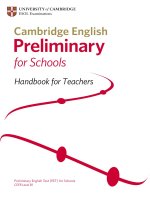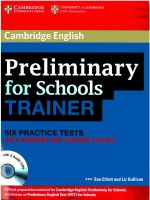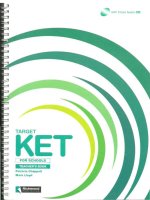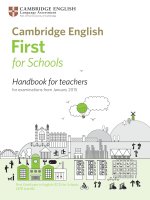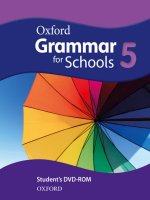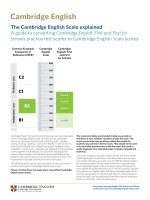preliminary for schools 2
Bạn đang xem bản rút gọn của tài liệu. Xem và tải ngay bản đầy đủ của tài liệu tại đây (4.52 MB, 175 trang )
CAMBRIDGE “ UNIVEoRf CSAMIBRTIDYGE
UNIVERSITY PRESS “-§”/ ESOL Examinauons
Cambridge English
PRELIMINARY
'WITH ANSWERS
Official preparation material for Cambridge English: Preliminary for Schools,
also known as Preliminary English Test (PET) for Schools
r
Cambridge English:
Preliminary for Schools
2
WITH ANSWERS
Authentic examination papers from
Cambridge ESOL
a CAMBRIDGE
ei) UNIVERSITY PRESS
CAMBRIDGE UNIVERSITY PRESS
Cambridge, New York, Meibourne, Madrid, Cape Town,
Singapore, Sio Paulo, Delhi, Mexico City
Cambridge University Press
The Edinburgh Building, Cambridge CB2 8RU, UK.
www.cambridge.org
Information on this title: www.cambridge.org/9781 107603103
© Cambridge University Press 2012
it is normally necessary for written permission for copying to be
obtained i advance from a publisher. The candidate answer sheets
at the back of this book are designed to be copied and distributed in class.
The normal requirements are waived here and it is not necessary to write
to Cambridge University Press for permission for an individual teacher to
make copies for use within his or her own classroom. Only those pages
which carry the wording ‘© UCLES 2012 rs may be copied.
First published 2012
Printed in the United Kingdom at the University Press, Cambridge
A catalogue record for this publication is available from the British Library
ISBN 978-1-107-603103 Student’s Book with answers
ISBN 978-1-107-603097 Student’s Book without answers
ISBN 978-1-107-603110 Audio CD Set
ISBN 978-1-107-603127 Self-study Pack
Cambridge University Press has no responsibility for the persistence or
accuracy of URLs for external or third-party internet websites referred to in
this publication, and does not guarantee that any content on such websites is,
or will remain, accurate or appropriate. Information regarding prices, travel
timetables and other factual information given in this work is correct at
the time of first printing but Cambridge University Press does not guarantee
the accuracy of such information thereafter.
Contents
Acknowledgements 4
A Guide to Cambridge English: Preliminary for Schools 5
Test 1 14
Test 2 34
Test 3 54
Test 4 74
Frames for the Speaking test 94
Test 1 Key 106
Test 2 Key 120
Test 3 Key 433
Test 4 Key 147
Sample answer sheets 161
Visual material for the Speaking test colour section at centre of book
Acknowledgements
The authors and publishers acknowledge the following sources of copyright material and
ate grateful for the permissions granted. While every effort has been made, it has not always
been possible to identify the sources of all the material used, or to trace ail copyright holders.
If any omissions are brought to our notice, we will be happy to include the appropriate
acknowledgements on reprinting.
Llangollen Motor Museum for text on p. 19 adapted from www.llangollenmotormuseum.co.uk.
Reproduced with permission; Aquila for the text on p. 19 adapted from “Look at Museums’
Aquila Children’s Magazine January 2008. All rights reserved. Reproduced with permission;
National Geographic for the text on p. 40 adapted from ‘Interview with Fredrick Hiebert’ National
Geographic Kids. Copyright © 1996-2012 National Geographic Society. All rights reserved; NI
Syndication for the text on p. 59 adapted from “Adam Clark hopes to take flight at Olympics” by
Cathy Harris, The Times 13/2/2009/ Copyright © The Times/NI Syndication 2009.
Black & white photos:
p. 16 (T): Thinkstock/Roger Weber; p. 16 (UC), 36 (C), 39 (TR), 56 (C & BC), 76 (C) and 80:
Thinkstock; p. 16 (C): Thinkstock/Photodisc; p. 16 (BC) and 76 (UC): Glow Images; p. 16 (B):
Getty Images/David Sacks; p. 19: © Howard West/Alamy; p. 20: © Kevin Dodge/Corbis; p. 36 (T)
and 56 (B): Thinkstock/Comstock Images; p. 36 (UC) and 60: Thinkstock/Jupiterimages; p. 36
(BC): Shutterstoci/T-Design; p. 36 (B): Thinkstock/Ciaran Griffin; p. 39 (TL): Shutterstock/Andrey
Shadrin; p. 40: Marco Ansaioni/Look At Sciences/Science Photo Library; p. 56 (T): Thinkstock/
David De Lossy; p. 56 (UC): Thinkstock/George Doyle; p. 59: Shutterstock/Leonid Shcheglov;
p. 62: Getty Images; p. 76 (T): Thinkstock/Pixland; p. 76 (BC): Thinkstock/Stockbyie; p. 76 (B):
Thinkstock/Photodisc; p. 79: Shutterstock/Olga Rutko.
Colour photos:
p. II (T): Photofusion/John Birdsall; p. IV (T): Getty Images/GSO Images; p. IV (B): Getty Images/
Lucianne Pashley; p. 1I (B), VI (T & B} and VIII (T): Cambridge ESOL; p. Vill (B): Photolibrary
Group; p. VIlt (C): Mark Peterson/CORBIS.
Picture research by Diane Jones recorded at dsound, London.
Design concept by Peter Ducker MSTD
The CDs which accompany this book were
A Guide to Cambridge English: Preliminary
for Schools
Cambridge English: Preliminary for Schools
Cambridge English: Preliminary for Schools, also known as Preliminary English Test (PET) for
Schools, is an examination that shows a pupil can deal with everyday written and spoken English
at an intermediate level.
Cambridge English: Preliminary for Schools follows exactly the same format as the popular
English test, Cambridge English: Preliminary, also known as Preliminary English Test (PET), and
the level of the question papers is identical. The only difference is that the content and treatment
of topics in Cambridge English: Preliminary for Schools have been particularly targeted at the
interests and experience of school pupils, enabling them to:
* learn skills to communicate in English
* gain an internationally recognised certificate
* build confidence in learning a valuable life skill.
Cambridge English: Preliminary for Schools is a version of Cambridge English: Preliminary, also
known as Preliminary English Test (PET), developed with exam content and topics targeted at
the interests of school-age learners. It is at Level B1 of the Common European Framework of
Reference for Languages (CEFR).
Cambridge English: Preliminary has been accredited by Ofqual, the statutory regulatory authority
for external qualifications in England and its counterparts in Wales and Northern Ireland.
Examination Council of Europe UK National
Framework Level Qualifications
Cambridge English: Proficiency Framework Level
Certificate of Proficiency in English (CPE) ca
C1 8
Cambridge English: Advanced B2
Certificate in Advanced English (CAE) B1 ?
Cambridge English: First for Schools
A2 1
First Certificate in English (FCE)
Entry 3
Cambridge English: Preliminary for Schools
ntry
Preliminary English Test (PET) for Schools
Entry 2
Cambridge English: Key for Schools
Key English Test (KET)
Successful Cambridge English: Preliminary for Schools candidates receive a certificate that is
accepted by employers, further education and government departments for business, study and
immigration purposes. Taking this exam is also useful preparation for higher level exams, such as
Cambridge English: First, Cambridge English: Advanced and Cambridge English: Proficiency.
Cambridge English exams are developed and produced by University of Cambridge ESOL
Examinations (Cambridge ESOL). Over 3.3 million people take Cambridge English exams each
A Guide to Cambridge English: Preliminary for Schools
year in 130 countries. Globally, over 12,000 universities, employers, government ministries and
other organisations rely on Cambridge English exams as proof of language ability.
Topics
These are the topics used in the Cambridge English: Preliminary for Schools exam:
Clothes Hobbies and leisure Services
Daily life House and home Shopping
Education Language Social interaction
Entertainment and media People Sport
Environment Personal feelings, experiences The natural world
and opinions
Food and drink Personal identification Transport holidays
Free time Places and buildings Travel and
Health, medicine and exercise | Relations with other people Weather
Cambridge Engiish: Preliminary for Schools content: an overview
Paper | Name Timing Content Test focus
Paper 1 | Reading/ Assessment of candidates’ ability to
| 1 hour Reading: Five parts which understand the meaning of written
Paper Writing 30 minutes | test a range of reading skills English at word, phrase, sentence,
Paper with a variety of texts, ranging | paragraph and whole text level.
2 | Listening from short notices to longer
3 | Speaking continuous texts, Assessment of candidates’ ability
a to produce straightforward written
Writing: | English, ranging from producing
Three parts which test a range | variations on simple sentences to
of writing skills,
pieces of continuous text.
| 35 minutes j Four parts ranging from short | Assessment of candidates’ ability
(approx.) exchanges to longer dialogues | to understand dialogues and
and monologues. monologues in both informal and
neutral settings on a range of
| 10-12 Four parts: in Part 1, candidates | everyday topics.
minutes interact with an examiner; In Assessment of candidates’ ability to
per pair of | Parts 2 and 4, they interact express themselves in order to carry
candidates | with another candidate; In out functions at B1 level. To ask and
Part 3, they have an extended | to understand questions and make
appropriate responses. To talk freely
individual long tum.
on matters of personal interest.
Paper 1: Reading and Writing
Paper format
The Reading component contains five parts. The Writing component contains three parts.
Number of questions
Reading has 35 questions; Writing has seven questions.
A Guide to Cambridge English: Preliminary for Schools
Sources
Authentic and adapted-authentic real-world notices; newspapers and magazines; simplified
encyclopaedias; brochures and leaflets; websites.
Answering
Candidates indicate answers by shading lozenges (Reading), or writing answers (Writing) on an
answer sheet.
Timing
4 hour 30 minutes.
Marks
Reading: Each of the 35 questions carries one mark, This is weighted so that this comprises 25%
of total marks for the whole examination.
Writing: Questions 1-5 carry one mark each. Question 6 is marked out of five; and Question 7/8
is marked out of 15. This gives a total of 25, which represents 25% of total marks for the whole
examination.
Preparing for the Reading component
‘To prepare for the Reading component, you should read a variety of authentic texts, for example,
newspapers and magazines, non-fiction books, and other sources of factual material, such as
leaflets, brochures and websites. It is also a good idea to practise reading (and writing) short
communicative messages, including notes, cards and emails. Remember you won't always need
to understand every word in order to be able to do a task in the exam.
Before the examination, think about the time you need to do each part. It is usually approximately
§0 minutes on the Reading component and 40 minutes on the Writing component.
Reading Number of
questions
Part | Task Type and Format Task Focus 5
Reading real-world notices and other | 5
1 Three-option multiple choice. Five short short texts for the main message. 30
discrete texts: signs and messages, 5
postcards, notes, emails, labels, etc.
10
2 Matching. Reading multiple texts for
Five items in the form of descriptions of people | specific information and detailed
to match to eight short adapted-authentic texts. | comprehension.
Processing a factual text. Scanning |
3 True/False.
Ten items with an adapted-authentic long text. | for specific information while
disregarding redundant material.
4 Four-option multiple choice. Reading for detalled comprehension: |
Five items with an adapted-authentic long text. | understanding attitude, opinion and
writer purpose. Reading for gist,
inference and giobal meaning.
5 Four-option multiple-choice eloze. Understanding of vocabulary
Ten items, plus an integrated example, with and grammar in a short text, and
an adapted-authentic text drawn from (one of) | understanding the lexico-structural
a variety of sources. The text is of a factual or | patterns in the text.
narrative nature.
A Guide to Cambridge English: Preliminary for Schools
Preparing for the Writing component
Parti grammar. There is an example, showing
You have to complete five sentences which will test your one and three words to fill this gap. The
exactly what the task involves. You should write between as the first sentence.
second sentence, when complete, must mean the same
Itis essential to spell correctly and no marks will be given if a word is misspelleYdo.u will also lose the
Mark if you produce an answer of more than three words, even if your writing includes the correct answer.
Part 2
You have to produce a short communicative message of between 35 and 45 words in length. You
are told who you are writing to and why, and you must include three content points. These are
clearly aid out with bullet points in the questionT.o gain top marks, all three points must be in
your answer, so it is important to read the question carefully and plan what you will include. Marks
will not be deducted for smail errors.
Before the exam, you need to practise writing answers of the correct length. Answers that are too
short or too long will probably lose marks.
General Mark Scheme for Writing Part 2
Mark | Criteria
5 All three parts of message clearly communicated.
Only minor spelling errors or occasional grammatical errors.
4 All three parts of message communicated.
Some non-Impeding errors in spelling and grammar or some awkwardness of expression.
3 All three parts of message attempted.
Expression requires interpretation by the reader and contains impeding errors in spelling and
grammar.
All three parts of the message are included but the context is incorrect.
OR
Two parts of message are clearly communicated but one part is unattempted.
Only minor spelling errors or occasional grammatical errors.
2 ‘Only two parts of message communicated.
Some errors in spelling and grammar.
The errors in expression may require patience and interpretation by the reader and impede
communication.
Some relevant content to two or more points but response is unclear.
1 Only one part of message communicated.
Some attempt to address the task but response is very unclear.
0 Question not attempted, or totally incomprehensible response.
Part 3
You have a choice of task: either a story or an informal letter. You need to write about 100 words
for both tasks.
Make sure you practise enough before the exam. Reading simplified readers in English will give
you ideas for story writing. Also writing to a penfriend or e-pal will give you useful practice.
8
A Guide to Cambridge English: Preliminary for Schools
Mark Scheme for Writing Part 3
Examiners iook at four aspects of your writing: Content, Language, Organisation, and
Communicative Achievement.
Content focuses on how well you have fulfilled the task, in other words if you have done what
you were asked to do.
Language focuses on your vocabulary and grammar. This includes the range of language as well
as how accurate it is.
Organisation focuses on the way you put the piece of writing together, in other words if it is
logical and ordered, and the punctuation is correct.
Communicative Achievement focuses on how appropriate the writing is for the letter or story
and whether you have used the appropriate register.
For each of the criteria, the examiner gives a maximum of 5 marks; this gives an overall
maximum score of 20 for the Part 3 task.
Examiners use the following assessment scale:
Bt | Content Language Organisation Communicative
Achievement
5 All content is Uses a range of everyday Text is generally Uses the
relevant to the vocabulary appropriately, with well-organised and conventions of the
occasional inappropriate use of coherent, using a communicative
task. less common lexis. variety of linking task to hold the
Target reader is Uses a range of simple and some | words and cohesive target reader's
fully informed. complex grammatical forms with | devices. attention and
a good degree of control. communicate
Errors do not impede straightforward
communication, ideas.
4 Performance shares features of Bands 3 and 5.
3 Minor irrelevances | Uses everyday vocabulary Text is connected and | Uses the
and/or omissions | generally appropriately, while coherent, using basic | conventions of the
may be present. occasionally overusing certain linking words and communicative
a limited number of task in generally
Target reader lexis. appropriate ways
is on the whole Uses simple grammatical forms | cohesive devices.
informed. with a good degree of control. to communicate
While errors are noticeable, straightforward
meaning can stili be determined. ideas.
2 Performance shares features of Bands 1 and 3.
1 Irrelevances and | Uses basic vocabulary Text is connected Produces text that
misinterpretation | reasonably appropriately. using basic, high- communicates
Uses simple grammatical forms —_| frequency linking simple ideas in
of task may be with some degree of control. words. simple ways.
present.
Target reader Errors may impede meaning at
is minimally times.
informed.
9 Content is totally Performance below Band 1.
irrelevant.
Target reader is
not informed.
EE iil
A Guide to Cambridge English: Preliminary for Schools
Length of responses amount of words. Responses which are too short may not have an
Make sure you write the correct
adequate range of language and may not provide ail the i information that is required. Responses
which are too long may contain irrelevant content and have a negative effect on the reader.
Varieties of English
You are expected to use a particular vari iety of English with some degree of consistency in
areas such as spelling, and not for examp! le switch from using a British spelling of a word to an
American spelling of the same word.
Writing Number of
questions
Part | TaskType and Format Task Focus {5
Control and understanding
1 Sentence transformations. of B1 level/Oambridge 1
Five items, plus an integrated example, that are
theme-related. Candidates are given sentences and English: Preliminary 1
then asked to complete similar sentences using a grammatical structures.
different structural pattern so that the sentence stil Rephrasing and
has the same meaning. Candidates should use no reformutating information.
more than three words.
Short communicative message. Ashort piece of writing of
2 Candidates are prompted to write a short message 35-45 words focusing on
in the form of a postcard, note, email, ete.The communication of specific
prompt takes the form of a rubric to respond to. messages.
Writing about 100 words
3 A longer piece of continuous writing.
There is a choice of two questions, an Informal letter focusing on control and
or a story. Candidates are primarily assessed on four | range of language.
aspects of their writi ontent, Communicative
Achievement, Organisation and Language.
Paper 2: Listening answers
Paper format as they listen.
This paper contains four parts. sheet.
Number of questions to standard
25
Text types
All texts are based on authentic situations.
Cand A i n d s a w t e e r s ing indicate answers either by sl hading lozenges (Parts 1, 2 and 4) or writing
(Part 3) on an answer sheet. Candidates record their answers on the question paper
They are then given six minutes at the end of the test to copy these on to the answer
Recording information
Each text is heard twice. Recordings wil It contain a variety of accents corresponding
variants of native speaker accents.
Timing
About 35 minutes, including six minutes to transfer answers.
10
A Guide to Cambridge English: Preliminary for Schools
Marks
Each question carries one mark. This gives a total of 25 marks, which represents 25% of total
marks for the whole examination.
Part | Task Type and Format Task Focus Number of
Listening to identify key questions
1 Multiple choice (discrete). information from short 7
Short neutrat or informal monologues or dialogues. exchanges.
Seven discrete thres-option multiple-choice items
with visuals, plus one example.
2 Multiple choice. Listening to identify specific | 6
Longer monologue or interview (with one main information and detailed
speaker). meaning.
Six three-option multiple-choice items.
3 Gap-fill. Listening to identify, 6
Longer monologue. understand and interpret
Six gaps to fill in. Candidates need to write one or information.
more words in each space.
4 True/False. Listening for detailed 6
Longer informal dialogue. meaning, and to identify the
Candidates need to decide whether six statements attitudes and opinions of
are correct or incorrect. the speakers.
Preparing for the Listening paper
You will hear the instructions for each task on the recording, and see them on the exam paper.
In Part 1, there is also an example text and task to show you how to record your answers.
in Parts 2, 3 and 4, the instructions are followed by a pause; you should read the questions in that
part then. This will help you prepare for the listening.
The best preparation for the listening paper is to listen to authentic spoken English at this level.
Having discussions provides a good authentic source of listening practice, as does listening to the
teacher. You can also listen to texts to give you practice in understanding different voices and
styles of delivery.
Paper 3: Speaking
í; Paper format
The standard format is two candidates and two examiners. One of the examiners acts as an
Ệ interlocutor and the other as an assessor. The interlocutor directs the test, while the assessor
takes no part in the interaction.
Timing
10-12 minutes per pair of candidates.
Marks
Candidates are assessed on thelr performance throughout the test. There are a total of 25 marks
in Paper 3, making 25% of the total score for the whole examination.
1
A Guide to Cambridge English: Preliminary for Schools
Part | Task Type and Format Task Focus Timing
2-3
1 Each candidate interacts with the Giving information of a factual, personal minutes
interlooutor. kind. The candidates respond to 23
The interlocutor asks the candidates questions about present circumstances, minutes.
questions in turn, using standardised past experiences and future plans.
questions. 3
minutes
2 Simulated situation. Candidates interact | Using functional language to make 3
with each other. and respond to suggestions, discuss minutes
Visual stimulus is given to the alternatives, make recommendations and
candidates to aid the discussion task. negotiate agreement.
The interlocutor sets up the activity
using a standardized rubric.
3 Extended turn. Describing photographs and managing
A colour photograph is given to each discourse, using appropriate vocabulary,
candidate in turn and they are asked in a longer turn.
to talk about it for up to a minute. Both
photographs relate to the same topic.
4 General conversation. Candidates The candidates talk together about thelr
interact with each other. opinions, likes/dislikes, preferences,
The topic of the conversation develops experiences, habits, etc.
the theme established in Part 3.
The interfocutor sets up the activity
using a standardised rubric.
Assessment
Throughout the Speaking test, examiners listen to what you say and give you marks for how well
you speak English, so you must try to speak about the tasks and answer the examiner and your
pariner’s questions.
You are awarded marks by two examiners; the assessor and the interlocutor. The assessor
awards marks from the Analytical Assessment scales for the following criteria:
Grammar and Vocabulary
This refers to the how accurately you use grammar and also to the correct use of vocabulary. It
also includes how wide a range of grammar and vocabulary you use.
Discourse Management
This refers to the length, relevance and coherence of your answers. You should be able to produce
sentences which are clear and easy to follow. What you say should be related to the topic and the
conversation in general.
Pronunciation
This refers to the how easy it is to understand what you say. You should be able to say words and
sentences that are easy to understand.
interactive Communication
This refers to how well you can talk about the task and to your partner and the examiner. You should
be able to start the conversation and keep it going, and ask for repetition or clarification if needed.
12
A Guide to Cambridge English: Preliminary for Schools
Grammar and Vocabulary | Discourse Management Pronunciation Interactive
‘Shows a good degree Produces extended Is intelligible. Communication
of control of simple Stretches of language Intonation is generally Initiates and responds
grammatical forms, and despite some hesitation. appropriate. appropriately.
attempts some complex Contributions are relevant Sentence and word
Maintains and develops
grammatical forms. despite some repetition. stress is generally the Interaction and
Uses a range of appropriate | Uses a range of cohesive accurately placed. negotiates towards an
vocabulary to give and devices. Individual sounds are
‘outcome with very little
exchange views on familiar generally articulated support.
topics. clearly.
4 Performance shares features of Bands 3 and 5.
3 Shows a good degree Produces responses which | Is mostly intelligible, Initiates and responds
are extended beyond short | and has some control of | appropriately.
of control of simple
grammatical forms. phrases, despite hesitation. | phonological features at | Keeps the interaction
Uses a range of appropriate | Contributions ara mostly both utterance and word | going with very litte
vocabulary when talking relevant, but there may be levels. prompting and support,
about familiar topics. some repetition.
Uses basic cohesive devices.
2 Performance shares features of Bands 1 and 3.
1 Shows sufficient control of Produces responses which | Is mostly intelligible, Maintains simple
simple grammatical forms. are characterised by short despite limited control of | exchanges, despite
Uses a limited range of phrases and frequent phonological features. some difficulty.
appropriate vocabulary to hesitation. Requires prompting
talk about familiar topics, Repeats information or and support.
digresses from the topic.
0 Performance below Band 1.
The examiner asking the questions (the interlocutor) gives marks for how weil you do overall
using a Global Achievement scale.
B1 Global Achievement
5 Handles communication on familiar topics, despite some hesitation,
‘Organises extended discourse but occasionally produces utterances that lack coherence, and some inaccuracies
and inappropriate usage occur.
4 Performance shares features of Bands 3 and 5.
3 Handles communication in everyday situations, despite hesitation.
Constructs fonger utterances but is not able to use complex language except in well-rehearsed utterances.
2 Performance shares featuofrBeansds † and 3.
4 Conveys basic meaning in very familiar everyday situations.
Produces utterances which tend to be very short - words or phrases ~ with frequent hesitation and pauses.
0
Performance below Band 1.
Further information
More information about Cambridge English: Preliminary for Schools or any other Cambridge
ESOL examination can be obtained from Cambridge ESOL at the address below or from the
website at www.CambridgeESOL.org_
University of Cambridge ESOL Examinations Telephone: +44 1223 553355
Hills Road Fax: +44 1223 460278
Cambridge CB1 2EU email: ESOLHe@ Clamp briddge eESsOLk .org
United Kingdom
13
Test 7
PAPER 1 READING AND WRITING TEST (1 hour 30 minutes)
1= NG
Part 1 sheet.
Questions 1-5 A
B
Look at the text in each question. ¢
What does it say?
Mark the correct letter A, B or C on your answer
Example: SKATEBOARDERS! Do not skateboard if other people are in
the park.
° Take care when skateboarding with
other skateboarders.
REMEMBER - THIS PARK IS Make sure you don’t skateboard outside
SHARED WITH OTHERS - the skateboarding zone,
KEEP TO THE MARKED AREAS.
Answer: | 9 ABE
Lift out of order A There will soon be a new lift to the
until further notice. upstairs labs,
Access to chemistry labs
B Students and staff cannot get to the
by the stairs. science labs at the moment.
€ You have to walk up to the labs
because the lift is not working,
2 A You are allowed to wear your trainers in
Remove ali shoes the sports hall.
(not including trainers) 8
before entering sports B You are asked to put your shoes inside
hall. the sports hall.
Leave on shelves outside.
© You must piace your trainers on the
14 shelves outside the sports hall.
Hi Jerry! Can | have a lift to Reading
the ice hockey game on A Pete is telling Jerry about a brilliant
Saturday if your Dad’s taking
Let me know. sports match he saw on Saturday.
Pete B Pete is asking if Jerry’s Dad can drive
4 him to a sports match.
C Pete is inviting Jerry and his father to
Mobile Phone
play in a sports match.
Discovered under seats in
Screen 1. You should contact the ticket office
A to find out about a phone that was left
Contact cinema ticket office
for further information. at the cinema.
B to ask them if a phone was found at the
cinema.
C to tell them about a phone thai you
found at the cinema.
5 A Tom isn’t sure he is fit enough to sail in
the competition.
From: Tom
B Tom wants Natasha to tell the club if
To: Natasha she will be in the competition.
Subject: Sailing © Natasha must let Tom know if she can
sail at the weekend.
Hope you'll be well enough for
us to enter the competition next
weekend. Get in touch because
I need to tell the club soon.
15
Test †
Part 2
Questions 6-10
The young people below ail want to go to an activity camp.
On the opposite page there are descriptions of eight activity centres.
Decide which activity camp would be the most suitable for the following people.
For questions 6-10, mark the correct letter (A-H) on your answer sheet.
Rafael will be 11 years old next month. He would like to
spend the day of his birthday at an activity camp where
he and his friends can do watersports all day and then
eat together.
Angela is in a junior ski team. She is keen to spend a
week in the mountains at an activity camp where she can
learn another winter sport and get a certificate.
Lucy and Claire are twins. They want to spend a fortnight
during their holidays taking part in sports competitions
and finding new friends. They want to share a room
together.
Panos needs to get fitter so he can join his focal football
team. He only has a few days free so he wants to do a
short course which isn’t too expensive.
Ahmed is the best runner at his school. He wants to
spend time at an activity camp by the sea this summer
where he can have private lessons in his sport.
Reading
Activity Camps
Beaumont Camp This camp offers B_ PLD Activities PLD Activities offers
weekends where families can take teenagers a chance to meet other young
part in different activities at any people during a two-week course in the
time of the year. Situated near the summer. Sports offered are running,
Black Mountains, the camp has cycling, football and tennis. Every week
a swimming pool, climbing wall, there are races to enter and prizes for the
football field and a running track. best sportsperson. Accommodation is in
Accommodation is in family rooms either single or double rooms.
which can sleep two adults and four
children.
Youth Activity Camp This camp in Creek Activity Camp This camp is open
the seaside town of Redbridge offers all year round. It is in a valley in the Mirren
both tennis and athletics training in Mouniains. Sports available are ice skating,
small classes. Courses last for one climbing, cycling and tennis and courses are
week and at the end, competitions are one week in length and can lead to a diploma.
held with certificates for the winners. Accommodation is in shared rooms and prices
Accommodation is in single rooms and all are reasonable.
meals are provided.
Westside Westside offers young people Eagle Camp Eagle Camp is open all year and is
the chance to sail by the sea one week situated by Eagie Lake in the Border Mountains.
and learn to ski in the mountains the next, Come for one day or one month! Eagle Camp
while making friends. offers a range of activities from sailing to
Private lessons are available and swimming and table tennis to football. Luxury
accommodation is first class, Not the accommodation is in specially-built houses and
cheapest holiday but well worth the money. there is both a restaurant and café.
Hilltop Young people can Derwent Activities Derwent Activities
improve their physical offer a range of activities such as
running, football, sailing and even
condition at the camp on South surfing at their seaside centre. One-
Beach. To keep costs down, Yto-one training is available in all sports
everyone camps and courses are and courses are two weeks in length.
in groups of five. There is both Accommodation {in rooms for four
a gym and a running track. children) and food are provided in a local
Courses are held during the hotel.
summer holidays, either over
two or five days.
17
Test 7
Part 3
Questions 11-20
Look at the sentences below about a writing competition.
Read the text on the opposite page to decide if each sentence is correct or incorrect.
if it is correct, mark A on your answer sheet.
If it is not correct, mark B on your answer sheet.
11 This competition is organised by a magazine for young people.
12 An article about Llangollen Motor Museum was last year’s competition winner.
13 Visitors to the Llangollen Motor Museum think it is quite an unusual and amusing museum.
14 One way to research your article is to talk to people working at your chosen museum.
15 The title of your article has to be My Favourite Museum.
16 Other people are allowed to give you advice about your article.
17 itis essential that you supply pictures with the article that you write.
18 Every page of your article should have your personal details included.
19 The magazine will publish a selection of the best articles in September's copy.
20 An additional two, or more, writers will win books as prizes.
18
